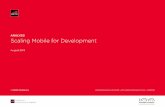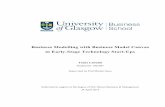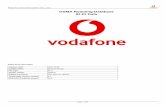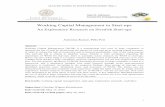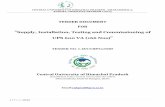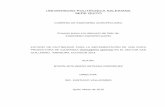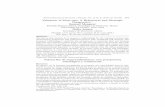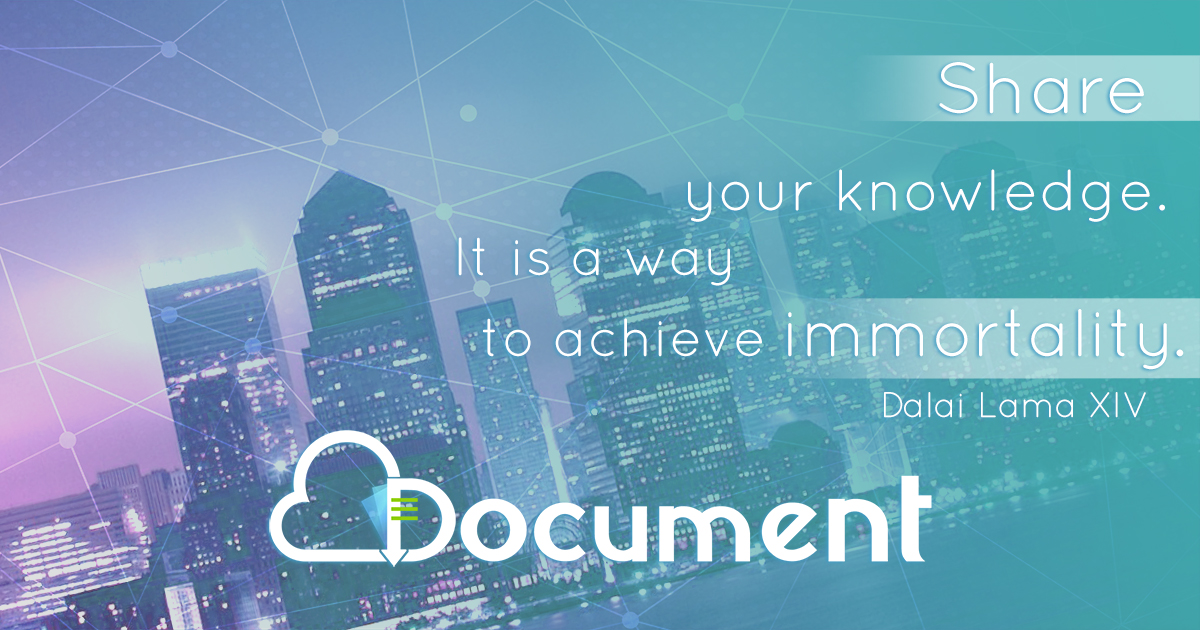Start-Ups and Mobile in Emerging Markets - GSMA
-
Upload
khangminh22 -
Category
Documents
-
view
2 -
download
0
Transcript of Start-Ups and Mobile in Emerging Markets - GSMA
© GSM Association 2018
Start-Ups and Mobile in Emerging MarketsInsights from the GSMA Ecosystem Accelerator
Issue 4, Winter 2018
2 3
START-UPS AND MOBILE IN EMERGING MARKETS: INSIGHTS FROM THE GSMA ECOSYSTEM ACCELERATORSTART-UPS AND MOBILE IN EMERGING MARKETS: INSIGHTS FROM THE GSMA ECOSYSTEM ACCELERATOR
Max Cuvellier
Head of M4D Utilities and Ecosystem Accelerator, GSMA
forms these collaborations can take, from co-innovation on IoT and aquaculture (eFishery/Telkomsel in Indonesia) to democratising solutions (Ensibukko/Airtel+MTN in Uganda) or building new logistics value chains (Musanga Logistics/MTN in Zambia). These joint efforts are made possible by entrepreneurs’ vision and matched by multiple mobile operator initiatives to play an enabling role in the ecosystem (Section 2).
As is now customary in our Start-ups and Mobile in Emerging Markets report, we zoom in on one vertical to highlight how mobile innovation is impacting the UN SDGs. In this issue, we selected EdTech, as education — from K–12 to skills development for the workforce — holds the key to socio-economic development in countries across Africa and Asia Pacific and, increasingly, more start-ups are developing solutions to turn this challenge into an opportunity. Once again, local mobile operators have the potential to help EdTech services reach critical mass quickly and more efficiently as exemplified by the partnerships between our Innovation Fund grantees Ruangguru and Telkomsel in Indonesia, and Eneza and multiple operators in Africa (MTN, Orange, Safaricom and Tigo).
We hope you find the stories in this issue helpful and inspiring, and we look forward to hearing your feedback and experience.
The Ecosystem Accelerator programme focuses on bridging the gap between mobile operators and start-ups, enabling strong partnerships that foster the growth of innovative mobile products and services. These partnerships bring impactful mobile solutions to the people and places that need them most, generating the greatest socio-economic impact. In particular, the programme operates an Innovation Fund which supports African and Asian start-ups with direct funding, technical assistance, and connections with mobile operators. The Ecosystem Accelerator programme is supported by the UK Department for International Development (DFID), the Australian Government, the GSMA and its members.
Learn more at www.gsma.com/ecosystemaccelerator or contact us at [email protected]
Follow GSMA Mobile for Development on Twitter:@GSMAm4d
Authors:
Josie Middleton – Knowledge Manager, Ecosystem Accelerator, GSMA Sam Ajadi – Insights Manager, Ecosystem Accelerator, GSMA Maxime Bayen – Insights Director, Ecosystem Accelerator and M4D Utilities, GSMA
Contributors:
Peter Ndichu – Senior Market Engagement Manager, Ecosystem Accelerator, GSMAKaung Sitt – Market Engagement Manager, Ecosystem Accelerator, GSMA Martin Karanja – Market Engagement Director, Ecosystem Accelerator, GSMA
The GSMA represents the interests of mobile operators worldwide, uniting more than 750 operators with over 350 companies in the broader mobile ecosystem, including handset and device makers, software companies, equipment providers and internet companies, as well as organisations in adjacent industry sectors. The GSMA also produces the industry-leading MWC events held annually in Barcelona, Los Angeles and Shanghai, as well as the Mobile 360 Series of regional conferences.
For more information, please visit the GSMA corporate website at www.gsma.com
Follow the GSMA on Twitter: @GSMA.
The end of the year is always a good time to reflect on our activities over the last 12 months.
When we look at the Ecosystem Accelerator Innovation Fund portfolio, we can only be impressed by the progress and impact these start-ups have made in the last few months. As of November 2018, 1.6 million beneficiaries have been reached by the various projects funded by the programme, while the equivalent of £2.5 million of additional income has been unlocked collectively, through direct revenue increase for citizens and local businesses, savings or productivity gains. On the investment front, two-thirds of the start-ups have now raised follow-on funding totalling £32.9 million, the vast majority of which is commercial.
We are also proud to announce the latest additions to the portfolio: 11 companies from ecosystems as diverse as Benin, Ethiopia and Papua New Guinea, whose progress we are eager to support and share.
Facilitating partnerships between start-ups and mobile operators remain at the core of our work, as we believe more strongly than ever that these collaborations can unlock commercial opportunities for both parties while delivering strong socio-economic impact for local populations and businesses. The case studies covered in this report (Section 1) once again illustrate the different
This document is an output of a project funded by UK aid from the Department for International Development (DFID) and Australia’s Department of Foreign Affairs & Trade (DFAT), for the benefit of developing countries. The views expressed are not necessarily those of DFID and DFAT.
Foreword
Ecosystem Accelerator
4 5
START-UPS AND MOBILE IN EMERGING MARKETS: INSIGHTS FROM THE GSMA ECOSYSTEM ACCELERATORSTART-UPS AND MOBILE IN EMERGING MARKETS: INSIGHTS FROM THE GSMA ECOSYSTEM ACCELERATOR
Start-ups and Mobile Innovation 6
Mobile Operators in the News 24
Mobile Technologies for the SDGs 30
How our Innovation Fund start-ups are using mobile technology to offer services with impact
How mobile operators are collaborating with local start-ups
How EdTech start-ups in emerging markets are using mobile technology to tackle education challenges and beyond
Contents
6 7
START-UPS AND MOBILE IN EMERGING MARKETS: INSIGHTS FROM THE GSMA ECOSYSTEM ACCELERATORSTART-UPS AND MOBILE IN EMERGING MARKETS: INSIGHTS FROM THE GSMA ECOSYSTEM ACCELERATOR
Start-ups and Mobile Innovation
How our Innovation Fund start-ups are using mobile technology to offer services with impact
8 9
START-UPS AND MOBILE IN EMERGING MARKETS: INSIGHTS FROM THE GSMA ECOSYSTEM ACCELERATORSTART-UPS AND MOBILE IN EMERGING MARKETS: INSIGHTS FROM THE GSMA ECOSYSTEM ACCELERATOR
How the service works
Fish and shrimp farmers can either buy or lease eFishery’s smart feeding devices. Most choose to lease. This is how the service works:
A farmer buys or leases eFishery’s Smart Feeder. The leasing model allows farmers to pay a fixed monthly fee.
An eFishery agent visits the farmer to install the Smart Feeder and Smart Sensor by the farmer’s pond(s).
After installation, eFishery’s team onboards the farmer. The onboarding process includes teaching farmers how to use eFishery’s mobile app and device. eFishery can also help farmers to acquire and use smartphones.
Once the device is set up, the farmer inputs the type of fish or shrimp, quantity and feed pellet size they use into eFishery’s mobile Android app.
During the scheduled feeding times, eFishery’s in-water vibration-based sensor, combined with machine learning, detects and determines the appetite of the fish to avoid overfeeding or underfeeding. After deducing the relative hunger of the fish, the fish feeder releases an optimal amount of feed.
The farmer then inputs fish feeding frequency by configuring and scheduling feeding times.
The sensors collect and send real-time data, such as feed volumes and feed consumption levels, to the cloud. Farmers can access this data through eFishery’s web and mobile app on their smartphone, tablet or computer.
Aquaculture is expected to provide close to two-thirds of global food fish consumption by 2030, according to the UN Food and Agriculture Organization (FAO).2 With annual aquaculture production of more than five million tonnes, Indonesia has the third largest aquaculture output globally, behind only China and India.3 While this output is significant, Indonesia’s aquaculture sector has yet to reach its full potential. Over 80 per cent of the country’s 3.34 million aquaculture fishers and fish farmers still use manual methods.4 For instance, fish feeding, which accounts for up to 60 to 90 per cent of total production costs in commercial aquaculture, is primarily done using hand-feeding methods. These methods often result in underfeeding or overfeeding, leading to malnourishment, feed wastage and negative environmental impact.5
To solve these challenges, eFishery has launched an Internet of Things (IoT) mobile-based solution that
boosts the efficiency and productivity of fish and shrimp farmers. The solution, Smart Feeder, uses sensors to detect the appetite of fish and shrimp and automatically feeds them the optimal amount. The sensors collect and send data (such as feed volumes, feed consumption and transactional data) to the cloud where the data is aggregated, stored and analysed. Farmers can then access and track these actionable data and insights. Also, eFishery’s technology allows farmers to manage their ponds remotely via their phones.
As of October 2018, over 1,300 fish and shrimp farmers in the country have used eFishery’s solution, and the start-up has installed its devices in more than 3,000 fish and shrimp ponds across Indonesia. On average, fish farmers using the eFishery solution have increased profits by over 20 per cent.
Case Study 1
Founding year:
Geography:
Founding team:
Tweet pitch:
2013
Indonesia
Gibran Huzaifah – Co-founder and CEO Chrisna Aditya – Co-founder and CTO
eFishery offers an Internet of Things (IoT)1 and mobile-based smart feeding technology to improve efficiency and accountability in fish and shrimp farming.
www.efishery.com
eFishery: Number of Smart Feeders installed
FIGURE 1
eFishery: Shaping the future of Indonesia’s aquaculture industry
1 The Internet of Things (IoT) describes the coordination of multiple machines, devices and appliances connected to the internet through multiple networks. Find out more at: www.gsma.com/iot
2 FAO, 5 February 2014, “Fish farms to produce nearly two thirds of global food fish supply by 2030”, http://www.fao.org/news/story/en/item/213522/icode/
3 FAO, 2018, “The State of World Fisheries and Aquaculture”, http://www.fao.org/3/I9540EN/i9540en.pdf
4 Ipsos, 31 August 2016, “Indonesia’s Aquaculture Industry: Key Sector for Future Growth”, https://www.ipsos.com/en-id/indonesias-aquaculture-industry-key-sectors-future-growth
5 Overfeeding fish leads to food being wasted and changes in water quality. When fish are overfed, they produce a lot more waste than they normally would. That waste releases ammonia and nitrates into
the water, which have negative impacts on the environment.
123
46
5 7
7 28 81 158 249 354 516 705 958 1,398 2,021 3,011 4,2535,740
Q1 2015 Q2 2015 Q3 2015 Q4 2015 Q1 2016 Q2 2016 Q3 2016 Q4 2016 Q1 2017 Q2 2017 Q3 2017 Q4 2017 Q1 2018 Q2 2018
10 11
START-UPS AND MOBILE IN EMERGING MARKETS: INSIGHTS FROM THE GSMA ECOSYSTEM ACCELERATORSTART-UPS AND MOBILE IN EMERGING MARKETS: INSIGHTS FROM THE GSMA ECOSYSTEM ACCELERATOR
Working with mobile operators
“eFishery Smart Feeder brings a new business model and opportunity to Telkomsel. Most importantly, the solution will have a positive impact on Indonesia’s aquaculture industry and inspire other developers and start-ups to work on IoT-based solutions to solve Indonesia’s challenges. The project development is challenging, but eFishery’s team is highly capable and competent. The team has been fully committed and responded in meeting the expected outcome.”
— Amelia Kemalasari, General Manager Business Development, Telkomsel
Changing lives
Working with the GSMA Ecosystem Accelerator
eFishery has teamed up with Indonesia’s largest mobile operator, Telkomsel (178 million mobile connections as of September 2018).6 In March 2018, eFishery began working with Telkomsel Innovation Center (TINC), an initiative aimed at advancing the IoT ecosystem to support the development of commercial products in Indonesia. Through the TINC, Telkomsel and eFishery are developing Narrowband IoT (NB-IoT)7 devices for the aquaculture sector.
Each Smart Feeder needs to have a SIM card and internet access to perform its full functions. Compared to a standard mobile SIM card, an NB-IoT SIM card
will enable the feeder to connect to the internet with minimal data costs, making the feeder more affordable, especially for those with multiple devices. Therefore, working with Telkomsel on NB-IoT will reduce the mobile data costs of eFishery’s Smart Feeders.
Between March and September 2018, eFishery successfully completed an NB-IoT pilot with support from Telkomsel. The first commercial model of NB-IoT devices is now being rolled out.
In February 2018, eFishery received a grant from the Ecosystem Accelerator Innovation Fund to extend its value proposition to fish and shrimp farmers by adding more features to its product offerings, including a farm management feature and a financing dashboard that will connect farmers to financial institutions. The funding is also being used to conduct the NB-IoT pilot
project with mobile operator, Telkomsel.
By the end of the grant in early 2019, the project is expected to help over 1,000 small-scale fish farmers achieve a combined total of £100,000 in incremental revenue. This is expected to drive job creation at their farms.
Fish consumption per capita in Indonesia was estimated at close to 34 kg per year,8 a significant share of total protein consumed.9 By adopting eFishery’s Smart Feeder, small and mid-size fish farmers can increase their productivity, lower their costs and, in turn, reduce prices for consumers. According to a study conducted by eFishery, some farmers have seen up to a 92 per cent increase in net profit after a year of using eFishery’s devices.
Overfeeding in fish farming significantly increases the amount of organic matter like ammonia or nitrate in water. This is not only dangerous for aquatic organisms, but unsustainable for the industry over the long term. eFishery’s solution helps reduce and prevent overfeeding by allowing farmers to feed their fish and shrimp optimal amounts with less pollution in the water.
6 GSMA Intelligence: www.gsmaintelligence.com
7 NarrowBand-Internet of Things (NB-IoT) is a standards-based low-power wide area (LPWA) technology developed to enable a wide range of new IoT devices and services. NB-IoT significantly
improves the power consumption of user devices, system capacity and spectrum efficiency, especially in deep coverage. The battery life of more than 10 years allows a wide range of use cases. Learn
more at: https://www.gsma.com/iot/narrow-band-internet-of-things-nb-iot/8 Ipsos, 31 August 2016, “Indonesia’s Aquaculture Industry: Key Sector for Future Growth”, https://www.ipsos.com/en/indonesias-aquaculture-industry-key-sectors-future-growth.
9 FAO, 2015, “The consumption of fish and fish products in the Asia Pacific region based on household surveys”, http://www.fao.org/3/a-i5151e.pdf.
“eFishery’s Smart Feeder has shortened our harvest cycles and improved our water quality. Our feeds are always in great nutritious condition since they are on top of the water for a much shorter period of time before being eaten. My pond’s feed conversion ratio has improved significantly. The shrimp sizes have evened out because the Smart Feeder distributes the feeds more evenly.”
– Rio Albab, Shrimp farmer from Karawang, West Java
“eFishery’s product surely helps improve feeding efficiency. The feed is more efficient because of the control and sensors from the feeder. We hope more farmers adopt eFishery’s innovation.”
– Slamat Soebjako, General Director of Aquaculture, Ministry of Marine and Aquaculture Indonesia
12 13
START-UPS AND MOBILE IN EMERGING MARKETS: INSIGHTS FROM THE GSMA ECOSYSTEM ACCELERATORSTART-UPS AND MOBILE IN EMERGING MARKETS: INSIGHTS FROM THE GSMA ECOSYSTEM ACCELERATOR
Musanga Logistics: Smoothing last-mile logistics while creating jobs for youth in Zambia
With an average distance of 4,100 km between major cities in Africa (compared to 1,300 km in Europe or 2,200 km in North America),10 logistics can pose significant challenges for businesses. For landlocked countries like Zambia, these challenges are even greater. A recent UNECA report estimated that, on average, transport costs in African landlocked countries account for 77 per cent of the value of their exports.11 Zambia ranks 118 out of 167 in logistics performance, lagging behind other Southern African counterparts like South Africa or Botswana.12 This erodes their competitiveness and affects the profitability of small and medium-sized enterprises (SMEs) that have to move goods around the country.
Meanwhile, Zambia’s youth represent almost two-thirds of the working-age population, yet youth unemployment rates are significantly higher than the national average.13
To tackle the problem of last-mile logistics while also fighting unemployment, Musanga Logistics launched an on-demand, mobile-based delivery solution that connects independent cyclists, motorbike riders and truck drivers to businesses and individuals in need of last-mile logistics support. Through the platform, merchants can access this fast, low-cost delivery service and get their products delivered within one to three hours in the capital, Lusaka. Merchants can track their inventory/packages via smartphone until they reach the agreed destination. Meanwhile, cyclists, motorbike riders and drivers with smartphones and underutilised assets (bicycles, motorbikes or trucks) can earn additional income on Musanga Logistics online marketplace. Musanga Logistics expects to have over 1,500 trucks registered on its platform by early 2019.
Case Study 2
How the service works
Founding year:
Geography:
Founding team:
Tweet pitch:
2016
Zambia
Njavwa Mutambo – Co-founder and CEOEmmanuel Kwenda – Co-founder and CFO
Musanga Logistics’ mobile platform connects a network of independent cyclists, riders and drivers to businesses and individuals in need of logistical support.
www.musanga.com
Musanga Logistics has developed two mobile apps available in both Android and iOS stores. The first one allows merchants to arrange a delivery and track packages in real time through their smartphones. The second one was created for drivers and riders to access and manage delivery requests. This is how the service works:
1
3
54
7
8
6
2
A merchant downloads, registers and logs in to the Musanga Logistics platform through their smartphone or mobile-responsive web app.
After requesting a delivery, the merchant enters the details of the package: weight, size, item, contact name, merchant location and recipient’s location.
The driver accepts the delivery job and heads to the pick-up location to collect the package. The merchant can track the driver and the package in real time.
Once the driver reaches the recipient’s location, they deliver the item(s) and prompt the recipient to pay for the package using mobile money (with MTN Mobile Money currently) or cash and to sign for the package on the driver’s smartphone. The recipient then receives a receipt of the transaction that is visible to the merchant on the app. (Musanga Logistics usually gets merchants to pay for their transaction at the beginning of each month to mitigate the risk of dealing with cash.)
Once the transaction is completed, the delivery driver/rider and the merchant can rate the service.
The merchant can immediately see available drivers in real time.
The merchant then requests a pick-up service. Musanga’s platform matches the request with available drivers.
Before heading to the delivery location, the driver initiates contact with the recipient to schedule a delivery window. Once agreed, the driver heads to the recipient’s location. Meanwhile, the merchant can track the driver in real time via Musanga’s mobile and web app.
Kilometers travelled by Musanga Logistics’ drivers and riders per month
FIGURE 2
10 BCG, April 2018, “Pioneering One Africa: The Companies Blazing a Trail Across the Continent”, http://image-src.bcg.com/Images/BCG-Pioneering-One-Africa-Apr-2018_tcm9-188261.pdf
11 Export-Import Bank of India, March 2018, “Connecting Africa: Role of Transport Infrastructure,” https://www.tralac.org/images/docs/12896/connecting-africa-role-of-transport-infrastructure-exim-bank-
working-paper-march-2018.pdf
12 The World Bank, Aggregated LPI 2012–2018, https://lpi.worldbank.org/international/aggregated-ranking
13 Republic of Zambia Central Statistical Office, 2018, “Zambia in Figures 2018”, http://www.zamstats.gov.zm/phocadownload/Dissemination/Zambia in Figure 2018.pdf
4,389 3,477 3,6837,374 6,637
15,461
May-18 Jun-18 Jul-18 Aug-18 Sep-18 Oct-18
14 15
START-UPS AND MOBILE IN EMERGING MARKETS: INSIGHTS FROM THE GSMA ECOSYSTEM ACCELERATORSTART-UPS AND MOBILE IN EMERGING MARKETS: INSIGHTS FROM THE GSMA ECOSYSTEM ACCELERATOR
Changing lives
Working with the GSMA Ecosystem AcceleratorMusanga Logistics received a grant from the GSMA Ecosystem Accelerator Innovation Fund in February 2018 to expand its operations and platform in three cities across Zambia. The end goal is to empower microentrepreneurs (drivers, riders) who will in turn support local small businesses and shops.
By the end of the grant in early 2019, Musanga Logistics plans to have onboarded an additional 600 merchants (small shops and manufacturers) and over 670 drivers and riders. Beyond the funding, GSMA is also supporting Musanga to strengthen its relationship with Zambian mobile operators.
Working with mobile operators
In October 2018, Musanga Logistics signed a mobile money integration partnership with MTN Zambia, the leading mobile operator in the country by customer market share with 5.9 million connections. The MTN Zambia partnership simplifies Musanga’s payment collection and reduces reliance on cash. Cash payments are still the preferred way to pay for deliveries, but it is inherently costly and risky
since the payment has to be manually counted, collected, verified, recorded, stored, secured and transported. Beyond providing a payment solution, Musanga’s partnership with MTN will also enable its users and drivers to access mobile financial services, for example, microloans that would allow drivers to purchase fuel ahead of deliveries.
“The MTN Zambia-Musanga Logistics partnership is an exciting opportunity to help the people of Zambia. I am a firm believer in Africa’s potential in the platform economy.”
— Charles Molapisi, CEO, MTN Zambia
“I began working with Musanga Logistics in March 2018. Musanga Logistics’ delivery requests are reliable and dependable. It has become my main source of income. So far, I have earned an average of $1,200 monthly. I am relying on my income from Musanga to buy another truck.”
– Kevin Musa, 31, Musanga Logistics driver
“Partnering with Musanga to deliver products to our clients has helped us as a company reduce our cost of delivery and improve on lead time. This has helped the business reduce costs and consequently maximise profits. But ultimately, Musanga Logistics has helped us gain customer confidence by ensuring our products reach customers on time.”
– Emmanuel Mwanza, 23, Shop owner
The average Musanga Logistics truck driver, cyclist and motorbike rider earn $432 per week, significantly higher than the average wage of other drivers and riders in Zambia. Musanga Logistics is creating employment opportunities for youth and helping those working in the informal economy become active participants in the formal economy. (The average age of drivers and riders on the platform is 28.) The start-up is also helping to boost the economic productivity of businesses with faster and lower cost deliveries. The solution has already helped businesses/merchants reduce their logistics costs by up to 40 per cent.
Musanga Logistics has reduced average customer delivery time from seven hours to three hours. By making use of a driver/rider’s underutilised assets, Musanga Logistics has reduced inefficiencies in the supply chain (i.e. half-empty trucks doing most deliveries) and the negative per capita environmental impact while contributing to a more sustainable city.
Driver app:
Merchant app:
14 GSMA Intelligence: www.gsmaintelligence.com
16 17
START-UPS AND MOBILE IN EMERGING MARKETS: INSIGHTS FROM THE GSMA ECOSYSTEM ACCELERATORSTART-UPS AND MOBILE IN EMERGING MARKETS: INSIGHTS FROM THE GSMA ECOSYSTEM ACCELERATOR
Ensibuuko: Driving financial inclusion by digitising traditional saving groups
According to the FinScope 2018 survey,15 only three per cent of adults in Uganda had borrowed from a commercial bank in the 12 months prior to the survey and 11 per cent of adult savers had done so through a commercial bank.16 In contrast, approximately 50 per cent of adults who borrow and save do so informally through Savings and Credit Cooperatives (SACCOs), Village Savings and Credit Associations (VSLAs) or other informal channels.17 These informal groups often rely heavily on rudimentary manual practices that are prone to inefficiency, human error and fraud. Paper records are the default solution for documenting accounts and tracking transactions.
Since most SACCOs and VSLAs operate in cash, members who are unable to attend their group meetings have no means of making cash contributions or receiving group updates. The cash-based approach also means savings associations must either store cash contributions in a safe or deposit it in a bank. Both options are risky, cumbersome, labour intensive, and undermine the ability of these groups to increase financial inclusion for the
underbanked and unbanked.
To address these challenges, Ensibuuko launched its Mobis service in 2014. Mobis provides savings and lending groups with the option to manage their records digitally. The mobile-enabled solution helps groups become more transparent and accountable, which in turn puts them in a better position to receive financing from third parties. Mobis also increases the productivity and operational efficiency of the groups by reducing costs. It leverages existing mobile money services (MTN Mobile Money and Airtel Money) so that individual group members can conduct financial transactions, such as withdrawals, deposits or loan repayments, without having to be physically present.
As of September 2018, 47 SACCOs representing over 157,35518 active members were active on the platform. Between January and October 2018, over £11 million loan transactions have been made through the Mobis platform, with an average value of over £550 per loan.
Case Study 3
Founding year:
Geography:
Founding team:
Tweet pitch:
2014
Uganda
Gerald Otim – Co-Founder and CEO
Opio Obwangamoi David – Co-Founder
Ensibuuko provides a mobile platform that connects SACCOs and VSLAs to users and enables users to withdraw cash, make deposits or repay loans using their existing mobile money account.
www.ensibuuko.com
FIGURE 3
15 FSD Uganda, 2018, “FinScope Uganda 2018 Survey Report”, http://fsduganda.or.ug/finscope-2018-survey-report/
16 Mercy Corps, 2018, “Drivers of Digitization of SACCOs in Uganda: Drivers and Impact Study”, https://www.mercycorps.org/research/drivers-digitization-saccos-uganda
17 Ibid.
18 This figure is based on SACCO members that have made at least one transaction a year.
377 10,099 10,101 10,120 10,238 15,06145,978 49,675 54,065
101,891 110,742 122,189146,364156,579166,297
0
Q1
2015
Q2
2015
Q3
2015
Q4
2015
Q1
2016
Q2
2016
Q3
2016
Q4
2016
Q1
2017
Q2
2017
Q3
2017
Q4
2017
Q1
2018
Q2
2018
Q3
2018
Ensibuuko: Number of active SACCO members on Mobis
How the service worksEnsibuuko offers an end-to-end solution for SACCO/VSLA managers and their members. This is how the service works:
19 USSD technology, or Unstructured Supplementary Service Data, is an interactive, menu-based technology that is supported by most mobile devices:
https://www.gsma.com/mobilefordevelopment/wp-content/uploads/2018/05/Start-ups-using-USSD-to-tackle-SDGs.pdf
For SACCO managers For SACCO members (once their SACCO grants them a loan and they want to repay it using MTN Mobile Money)
12
On the dashboard, SACCO managers can view all their accounts at a glance, categorised as Assets, Expenses, Equity/Capital, Income and Liabilities. They can track loans from the app through to disbursement and access a variety of automated reports such as Loan, Saving, Shares and Financial reports.
SACCO managers register and log in to the mobile-responsive Mobis web platform. 1
SACCO members can access Ensinbukko’s platform by dialling a USSD19 code *165# (MTN Mobile Money) or *185# (Airtel Money).
2
4
SACCO members are provided with a series of options, one of which is Financial Services.
They will be presented with options to Deposit, Withdraw or go Back to the previous menu.
3
5
From the Financial Services menu, the member selects the MSACCO option.
If member selects Deposit, they will be prompted to enter their MSACCO ID followed by their member ID then the amount being deposited. On the back end, MTN Mobile Money facilitates the deposit of mobile money from their MTN Mobile Mobile wallet to Ensibuuko’s platform.
18 19
START-UPS AND MOBILE IN EMERGING MARKETS: INSIGHTS FROM THE GSMA ECOSYSTEM ACCELERATORSTART-UPS AND MOBILE IN EMERGING MARKETS: INSIGHTS FROM THE GSMA ECOSYSTEM ACCELERATOR
Working with mobile operators
Ensibuuko partners with Airtel Uganda and MTN Uganda, the country’s two largest mobile operators (11 million and 10.7 million mobile connections, respectively, as of September 2018).20
In 2013, Ensibuuko began collocating its servers at Airtel Uganda’s data centre. Beyond this collaboration on the IT front, the mobile operator also provides a mobile data package at a discounted rate to Ensibuuko’s SACCOs/VSLAs to ensure their Mobis cloud platform is always connected to the internet. The start-up has integrated with Airtel Mobile Money API to allow Ensibuuko Mobis SACCO/VSLA members
to pay into and withdraw from their respective SACCO/VSLA using their mobile money accounts. In August 2018, Ensibuuko signed a partnership with MTN Uganda Mobile Money that allows SACCO/VSLA managers to disburse loans to members and enable users to make loan repayments through the Mobis platform.
The benefit of mobile money to SACCOs and their users cannot be overstated. According to recent research by Mercy Corps, by leveraging mobile money, Ensibuuko reduces the time it takes members to make a deposit to their SACCO/VSLA by up to 50 per cent.21
20 GSMA Intelligence: www.gsmaintelligence.com
21 Mercy Corps, 2018, “Drivers of Digitization of SACCOs in Uganda: Drivers and Impact Study”, https://www.mercycorps.org/sites/default/files/Digitization%20of%20SACCOs%20in%20Uganda%20-%20
Drivers%20and%20Impact%20Study.pdf
Changing lives
Working with the GSMA Ecosystem Accelerator
“Mobis system has helped us improve our operations. Firstly, when it comes to recording accuracy, before installing Mobis, all our operations were manual. We would update members’ ledger cards every evening and this was prone to errors. We would make arithmetic errors, posting to wrong ledgers where members shared names. This resulted in losses to the SACCO but since installing the system, these errors are no more. Secondly, we have witnessed growth in membership. Since introducing Mobis, our group membership has tripled. Before the system, our membership stood at around 400 members but since then the number has grown to over 1,500 members in two years. This growth has been possible because Mobis has helped managed all our transactions. Finally, Mobis has provided real-time reporting. We can retrieve reports as and when required. This has helped us maintain a good relationship with all stakeholders in our SACCO.”
– Bwambale Jofred, Manager, Stride Development SACCO, Rwenzururu Sub-Region
“The installation of Mobis in our SACCO brought a significant difference as far as information tracking is concerned. With the Mobis software, every report is generated automatically which enables us to be effective and efficient, speeding up the delivery of our services to our members.”
– Marion Twikiriize, Manager of Bushenyi SACCO, Ankole Sub-Region
According to a study conducted by Mercy Corps,22 Ensibuuko’s solution reduces SACCO managers’ workdays by two to four hours. The service also reduces processing time for loan repayments by 60 to 80 per cent and generates increased revenue for SACCOs of around four per cent. The efficiency gains have led to an increase in savings group members, further driving financial inclusion.
In February 2018, Ensibuuko received a grant from the Ecosystem Accelerator Innovation Fund to design, build and integrate a mobile banking platform in Ensibuuko’s existing group banking software platform that serves SACCOs and VSLAs. The mobile banking platform relies on mobile money, allowing SACCO members to deposit, withdraw and borrow from their
SACCOs, all on their mobile device via mobile money and SMS. By the end of the grant in early 2019, the platform aims to use mobile money to improve the quality and range of financial services available to over 65,000 SACCO and VSLA members across Uganda.
22 ibid.
Marion Twikiriize using the Mobis solution
“MTN Uganda partnered with Ensibuuko because, by offering banking solutions to SACCOs, they are addressing a real problem — financial inclusion for the unbanked. Financial inclusion is something that fits perfectly within MTN Uganda's agenda. I was privileged to be Ensibuuko's Relationship Manager at MTN at the start of this relationship and throughout their integration process. MNO integration can be a complex process, but Ensibuuko demonstrated true commitment to the process and made the process much easier. As Ensibuuko rolls out its mobile banking offering for SACCOs in partnership with MTN Uganda, I have no doubt that the service will mutually benefit both parties and deliver on our shared promise to bring financial services closer to millions of unbanked people in Uganda.”
– Sumayah Kyewalyanga, Corporate Account Manager, Mobile Money, MTN Uganda
“Airtel has been hosting Ensibuuko’s servers for the last five years and it is great to see Ensibuuko has supported many business entities with a huge dependence on servers hosted at Airtel’s Main Data Center. On behalf of Airtel, I wish to take this opportunity to appreciate Ensibuuko. We value Ensibuuko’s business and we are confident and hopeful that Ensibuuko will continue to touch and support the community through the provision of quality and dependable services.”
– Jeremiah Kasirye, Head of Network Infrastructure, Airtel Uganda
20 21
START-UPS AND MOBILE IN EMERGING MARKETS: INSIGHTS FROM THE GSMA ECOSYSTEM ACCELERATORSTART-UPS AND MOBILE IN EMERGING MARKETS: INSIGHTS FROM THE GSMA ECOSYSTEM ACCELERATOR
PrepClass: Introducing educational tutoring 2.0 in Nigeria
At over 80 million, Nigeria has the world’s third largest population of youth under 15 year.23 Yet, in terms of quality education and enrolment rates, its primary to higher school system is ranked 120 out of 135 countries globally.24 Currently, the government allocates only 7.1 per cent of its expenditure to education, less than a third of the UN’s recommended minimum of 25 per cent for countries seeking rapid development.25 This significantly affects the quality of education and results in poor teacher remuneration, low teacher attendance rates in public schools and lack of basic infrastructure and facilities.26
To tackle some of these issues, PrepClass launched a digital platform matching students to teachers. PrepClass enables face-to-face tutoring, either one-on-one or in groups. Through the platform, a pool of teachers who have been interviewed and thoroughly vetted offer their services to learners, providing a source
of income for tutors while improving the education of Nigeria’s students. PrepClass tutors work with students aged 4 to 16 years old (K–12 learners) as well as with 16 to 35 year olds with a focus on test preparation (in maths, English and science), language learning and vocational education.
As of October 2018, PrepClass had over 5,154 tutors registered on its platform available to be matched with learners. On average, tutors work with five learners per month. Between May 2017 and August 2018, over 143,000 hours of face-to-face tutoring have been delivered through the PrepClass platform. In January 2018, PrepClass launched a mobile app called PrepTest, which provides tutors with a platform to upload educational content for learners. As of October 2018, over 312,000 learners have downloaded the app and accessed nearly 83,000 hours of downloaded educational content.
Case Study 4
Founding year:
Geography:
Founding team:
Tweet pitch:
2013
Nigeria
Chukwuwezam Obanor – Co-Founder and CEO Olumide Ogunlana – Co-Founder and COO
A digital tutoring marketplace that connects learners and tutors.
prepclass.com.ng
FIGURE 4
23 The World Bank, Population aged 0–14 years (percentage of total): https://data.worldbank.org/indicator/SP.POP.0014.TO.ZS?contextual=population-by-age&end=2017&locations=NG&start=1960&view=chart
24 Nigeria Data Portal: http://nigeria.opendataforafrica.org/infographics/clwiine/global-competitiveness?indicator=Quality%20of%20primary%20education%2C%201-7%20(best)
25 Tope Alake, 12 September 2018, “No Books, No Desks, No Pay: Nigeria’s Education System is Failing”, Bloomberg, https://www.bloomberg.com/news/articles/2018-09-12/no-books-no-desks-no-pay-
nigeria-s-education-is-failing
26 Ogunlana Olumide, 29 May 2017, “Nigeria Has an Acute Shortage of Teachers and Will Require 400,000 More Primary School Teachers between 2012 and 2030—Where Are All The Teachers????”,
https://medium.com/@ogunlanaolumide/nigeria-has-an-acute-shortage-of-teacher-and-will-require-400-000-more-primary-school-teachers-15253b9bff0f
Number of hours of PrepClass in-person tutoring lessons
9,943 18,817 32,01948,828 68,994
96,224120,254
143,439
How the service worksPrepClass uses an online web platform to recruit, manage and connect tutors to learners seeking academic support. This is how the tutoring service works:
27 Tutors fill in a form to inform PrepClass about their academic background, teaching experience, photo for their tutor profile and specify the subjects they will teach, and provide professional/ personal
reference.
28 Most PrepClass classes have two to three learners.
29 PrepClass conducts due diligence before placing tutors in learners’ homes. Tutors provide two guarantors and learners/parents sign a contract agreeing an adult must be present during tutoring
sessions.
For parents/learners For teachers/tutors
1
3
54
6
2PrepClass calls the parent/learner to schedule a visit. PrepClass then visits the parent/learner to validate the request and set monthly learning goals.
PrepClass matches learners with the most suitable tutors and notifies learners by SMS and a phone call that they have been matched with a tutor.
PrepClass bills the parent/learner at the end of the month. Upon receiving the bill, the parent/learner pays PrepClass and rates/reviews the servcie in a phone interview.
Parents/learners access the PrepClass website or apply via SMS, WhatsApp or by calling PrepClass and entering the learner’s details.
Parent/learner pays a registration fee by cash or via bank transfer (3,000 Naira per learner, or $8.25).
PrepClass lessons between tutors and learners take place at the scheduled time.
1Tutors complete a registration form on the PrepClass website.27
2
4
At the discretion of the PrepClass visitation officer, tutors are invited to be interviewed for further vetting and due diligence. During the interview, tutors complete three tests (personality, academic and teacher-student simulation) to establish a cumulative score and tutorial rank. The PrepClass visitation officer gives the tutors feedback on their score.
Tutors hold the tutoring classes with the learner(s).
3
5
PrepClass provides orientation training to tutors. Tutors are notified of a match with learners28 in a phone call and are given the opportunity to accept/reject the lessons. If the tutor accepts, a match is made between the tutor and learner(s).29
At the end of each month, tutors send PrepClass feedback, parents/learners are billed and tutors are paid within 48 hours (PrepClass retains a 30 per cent service fee).
22 23
START-UPS AND MOBILE IN EMERGING MARKETS: INSIGHTS FROM THE GSMA ECOSYSTEM ACCELERATORSTART-UPS AND MOBILE IN EMERGING MARKETS: INSIGHTS FROM THE GSMA ECOSYSTEM ACCELERATOR
Changing lives
The EdTech start-up is helping to address the issue of overcrowded classrooms that currently undermine the quality of education in Nigerian schools. According to The World Bank, the pupil to teacher ratio in Nigeria is 1:3430 compared to the world average of 1:24. Between May 2017 and August 2018, over 143,000 hours of face-to-face tutoring have been delivered through the PrepClass platform.
Through in-person tutoring, PrepClass unlocks financial opportunities for teachers. Between January 2015 and September 2018, PrepClass has enabled 5,154 teachers to generate additional income through its platform. The minimum monthly wage for a Nigerian primary school teacher is 18,000 Naira ($41) while high school teachers earn 37,000 Naira ($102).31 Since 2015, the average amount received by PrepClass tutors per month is around 64,000 Naira ($175).
“PrepClass has completely changed my perspective towards the benefits of being an educator. Prior to working with PrepClass, I earned a little above minimum wage. Now I earn more and my work hours are a lot more manageable. I work with two PrepClass learners for two hours a day, three times a week.”
– Anuforo Dominic, PrepClass Tutor
“I’m very impressed with Mr. Blessing’s (PrepClass tutor) method of teaching. My children enjoy his sessions and they have helped improve their performance in school.”
– Mrs Stevenson, parent of two PrepClass learners
“Ms Anthonia (PrepClass tutor) has been a very effective teacher for my daughter. She is patient and understanding. The lessons have significantly improved my daughter’s numeracy.”
– Mrs Amosu, parent of a PrepClass learner
Working with the GSMA Ecosystem Accelerator
PrepClass received a grant from the GSMA Ecosystem Accelerator Innovation Fund in April 2017 to increase the number of tuition sessions completed through the platform by connecting more learners and tutors via a web and mobile app and to develop the digital education content available on the mobile app.
Beyond funding, the Ecosystem Accelerator is supporting PrepClass in engaging with local and regional mobile operators to assess and plan potential partnerships.
30 The World Bank, Pupil-teacher ratio, primary: https://data.worldbank.org/indicator/SE.PRM.ENRL.TC.ZS
31 George Ibenegbu, 2018, “Teachers salary scale in Nigeria”, Legit, https://www.naija.ng/1138849-teachers-salary-scale-nigeria.html - 1138849
Working with mobile operatorsIn January 2018, PrepClass launched a native Android mobile app to enable students to prepare for the JAMB exam, a Nigerian entrance examination for prospective university undergraduates, through video courses.
Partnering with local mobile operators is instrumental to allow PrepClass to scale up its services across Nigeria and beyond. PrepClass team is currently in advanced discussions with the country's largest providers.
24 25
START-UPS AND MOBILE IN EMERGING MARKETS: INSIGHTS FROM THE GSMA ECOSYSTEM ACCELERATORSTART-UPS AND MOBILE IN EMERGING MARKETS: INSIGHTS FROM THE GSMA ECOSYSTEM ACCELERATOR
Mobile Operators in the News
How mobile operators are collaborating with local start-ups
26 27
START-UPS AND MOBILE IN EMERGING MARKETS: INSIGHTS FROM THE GSMA ECOSYSTEM ACCELERATORSTART-UPS AND MOBILE IN EMERGING MARKETS: INSIGHTS FROM THE GSMA ECOSYSTEM ACCELERATOR
The map below is a snapshot of mobile operator and start-up initiatives announced between July and October 2018. Each initiative has been mapped against a framework we developed in our 2017 report, Building Synergies:
Mobile operator and start-up collaborations in emerging markets (July to October 2018)
FIGURE 5
AFRICA
Econet and EdTech start-up Snapplify partner to zero-rate e-books (Aug 2018)
TUNISIA
Orange Summer Challenge 2018 Start-up Edition Tunisia (Oct 2018)
LIBERIA
Orange reveals winners of Orange Social Venture Prize Liberia 2018 (Sep 2018)
INVESTMENTSJOINT OFFERINGS CO-INNOVATIONS COMPETITIONS COMMERCIAL AGREEMENTS TECH HUBS APIS
BANGLADESH
Robi signs partnership deal with Bangladeshi start-up Sheba (Jul 2018)
SOUTH AFRICA
Orange Digital Ventures Africa invests in South African FinTech start-up Yoco (Sept 2018)
INDIA
Bharti Airtel bets on start-up AuthMe to bolster its AI play (Oct 2018)
PAKISTAN
Telenor Velocity partners with local tech hubs to accelerate the Pakistan start-up community (Aug 2018)
BANGLADESH
Banglalink launches ideation competition Ennovators 2.0 (Jul 2018)
CAMBODIA
Smart Axiata supports social ventures incubator Impact Hub Phnom Penh (Sep 2018)
How Mobile Operators and Start-ups Can Partner for Impact in Emerging Markets, including investments, competitions, APIs, commercial agreements and tech hub initiatives. In this issue we have added two more classifications (co-innovations and joint offerings). On the next page, we dive deeper into six of these initiatives.
GHANA
Vodafone launches coding programme for youth in Ghana (Sep 2018)
THAILAND
Dtac and agritech start-up Ricult team up to develop agronomy service (Oct 2018)
SENEGAL
Expresso Telecom launches the second edition of its Innovation Challenge (Oct 2018)
ZAMBIA
APIs: Musanga Logistics* partners with MTN Uganda to integrate MTN Mobile Money APIs (Oct 2018)
THAILAND
Dtac Accelerate Demo Day batch 6 announces winners (Sep 2018)
INDONESIA
GO-JEK and Grab partner with Telkomsel to strike mobile data discount partnerships for drivers (Jul 2018)
INDONESIA
Telkomsel opens IoT innovation centre and partners with aquatech start-up eFishery*(Aug 2018)
INDONESIA
Telkomsel and Ruangguru* launch a learning package for students (Aug 2018)
KENYA
TransportTech start-up BuuPass discusses the importance of Safaricom APIs (Oct 2018)
SOUTH AFRICA
MTN Solution Space runs a FinTech start-up weekend (Aug 2018)
KENYA
Airtel Kenya and Jumia pair up to offer mobile subscribers shopping vouchers (Jul 2018)
KENYA
mSurvey and Safaricom partner to collect M-Pesa customer feedback (Jul 2018)
BANGLADESH
Grameenphone announces seven finalists for Telenor Youth Forum (Sep 2018)
CAMBODIA
Smart Axiata Digital Innovation Fund invests in Agribuddy(Oct 2018)
* One of the start-ups funded by the GSMA Ecosystem Accelerator Innovation Fund
BOTSWANA
Orange Fab France selects Botswana start-up Brastorne for first ‘Women Start’ programme (Sep 2018)
28 29
START-UPS AND MOBILE IN EMERGING MARKETS: INSIGHTS FROM THE GSMA ECOSYSTEM ACCELERATORSTART-UPS AND MOBILE IN EMERGING MARKETS: INSIGHTS FROM THE GSMA ECOSYSTEM ACCELERATOR
Orange Digital Ventures Africa (ODVA) has made its second investment on the continent with Kenyan communication API start-up, Africa’s Talking, in April 2018.
Yoco runs a mobile point of sale (mPOS) solution in South Africa that allows merchants to accept card payments using a smartphone or tablet. Its solution also enables merchants to manage their day-to-day activities using the mPOS software. Launched in 2015, Yoco now works with over 27,000 SMEs in South Africa.
Yoco’s investment is a $16 million Series B round led by Partech Ventures with participation from ODVA and other investor. Yoco plans to use the funds to consolidate its position and expand its merchant network in South Africa. The funds will also be used to improve Yoco’s product and expand into new markets, notably in East Africa. According to Marc Rennard, CEO and Chairman of Orange Digital Venture, “Orange is already a leader in financial services in Africa with Orange Money, and it is on the lookout for solutions that can lead to genuine revolutions in use, both amongst customers and merchants. This is the case with Yoco.”
dtac (Telenor Group) has joined forces with AgriTech start-up Ricult and RBK (information services for farmers) to develop an agronomy service that allows farmers to receive a personalised weather forecast, crop advice and health monitoring through satellite image processing and advanced weather analytics. The mobile app, ’Farm Man Yum’, or ‘precision farm-ing’, was developed by Ricult.
The partnership combines dtac’s reach and marketing abilities, RBK’s information service and Ricult’s product development expertise to roll out the mobile agronomy solution to farmers. Through the partnership, dtac is expecting to reduce churn, attract and increase the ARPU32 of farmer users and provide an innovative service in rural areas. According to dtac, a third of the Thai population works in the agricultural sector, yet the sector only generates roughly 10 per cent of Thailand’s GDP.
Ricult started working with dtac in 2017 when the start-up was selected to join the fifth batch of dtac Accelerate, the mo-bile operator’s accelerator programme, which provides start-ups with funding and mentorship. After the programme, dtac Accelerate invested in Ricult’s seed funding round and became a shareholder in the AgriTech start-up. Co-innovating in the development of the agronomy service was the next step in this collaboration between the mobile operator and Ricult.
Mobile operator Econet Wireless and South African EdTech start-up Snapplify struck a partnership to make e-books available to readers at no additional mobile data cost. Snapplify is an e-book aggregator that offers access to leisure content, educational materials and e-learning platforms. Through the partnership, Snapplify’s catalogue of 240,000 e-books becomes zero-rated for Econet’s mobile users from Zimbabwe, Zambia, Malawi, Tanzania, Botswana, Lesotho, Ghana and Uganda.
Through this collaboration, both parties are reducing barriers to education on the continent and increasing access to digital education. The partnership also has the potential to unlock new users for Snapplify since Econet Wireless has a strong education arm, Econet Education, that focuses on providing mobile subscribers with access to world-class educational materials. Snapplify will be able to leverage Econet’s reach to acquire more readers, especially in Zimbabwe where the mobile operator is a market leader.
dtac and AgriTech start-up Ricult team up to develop agronomy mobile app
Orange Digital Ventures invests in South African FinTech start-up Yoco
Econet and EdTech start-up Snapplify partner to zero-rate e-books
Telenor Pakistan has launched a new initiative to widen the scope of its flagship accelerator programme, Telenor Velocity. The new initiative enables other incubators, accelerators, co-working spaces and investors to partner with Telenor Velocity and gain access to a suite of tools and services that can help accelerate the growth of local start-ups in Pakistan.
Local tech hubs, such as NIC Peshawar and NIC Karachi, Plan X, Plan9, NSPIRE, 10xC, GIKI and Daftarkhwan, have already joined what has been dubbed the Velocity Partnership Program, and their start-ups now have access to the Velocity Suite. The Velocity Suite includes access to Telenor’s customer base, APIs, payment integrations, expert mentoring and outreach to investors. Start-ups can gain access to the Velocity Suite virtually from the convenience of their co-working spaces.
Telenor Velocity partners with local tech hubs to accelerate the Pakistan start-up community
In September 2018, Brastorne was one of nine start-ups selected for Orange Fab France’s Women Start programme, an initiative dedicated to strengthening the business relationship between Orange and start-ups founded by women, and to encourage women in the technology and digital sectors to launch start-ups.
Brastorne focuses on bridging the digital gap for underserved communities through USSD, SMS and voice offerings. The start-up has two main products: Sedi and Mpotsa. Sedi enables access to internet services through feature phones. Through Sedi, users can have access to a chat function, Wikipedia, mobile marketplace, email and dedicated knowl-edge bases by dialling *118#. Over 600,000 users have tried the service to date. Mpotsa (‘Ask me’) is an SMS and voice service that enables Orange Botswana customers to ask questions based on their needs and receive answers through a content-based subscription service.
Brastorne has worked with Orange Botswana since 2016 through API integration on USSD and airtime billing. The Women Start programme is the next step for the company in its collaboration with Orange.
Orange Fab France selects Botswana start-up Brastorne for first ‘Women Start’ programme
TEC
H H
UB
TEC
H H
UB
In July 2018, Telkomsel struck up partnerships with ride-hailing players, GO-JEK and Grab, to allow their driver partners to gain access to mobile data credits of up to 15GB, unlimited free on-net calls, 200 minutes free off-net calls and 500 free on-net SMS for IDR 75,000 ($5) per month. The new partnership helps support the drivers’ daily communication needs.
The packages can only be used by Telkomsel users who are registered as GO-JEK or Grab’s driver partners. The package should help ease the mobile credit burden of drivers. According to data from GO-JEK, over 80 per cent of driver partners spend over IDR 150,000 ($10) per month on mobile credit and 62 per cent of its drivers use data packages above 10GB. Through the partnership, Telkomsel expects to turn GO-JEK and Grab drivers into consistent monthly mobile data users.
GO-JEK and Grab partner with Telkomsel to strike mobile data discount partnerships for drivers
32 Average revenue per user 33 GSMA Intelligence: www.gsmaintelligence.com
CO
-IN
NO
VATI
ON
CO
MM
ER
CIA
L A
GR
EE
ME
NT
JO
INT
OFF
ER
ING
SIN
VE
STM
EN
T
30 31
START-UPS AND MOBILE IN EMERGING MARKETS: INSIGHTS FROM THE GSMA ECOSYSTEM ACCELERATORSTART-UPS AND MOBILE IN EMERGING MARKETS: INSIGHTS FROM THE GSMA ECOSYSTEM ACCELERATOR
Mobile Technologies for the SDGs
How EdTech start-ups in emerging markets are using mobile technology to tackle education challenges and beyond
32 33
START-UPS AND MOBILE IN EMERGING MARKETS: INSIGHTS FROM THE GSMA ECOSYSTEM ACCELERATORSTART-UPS AND MOBILE IN EMERGING MARKETS: INSIGHTS FROM THE GSMA ECOSYSTEM ACCELERATOR
The most widely used ‘offline’ mobile technology remains SMS. Ghanaian start-up Chalkboard Education, for instance, uses SMS to provide access to university courses via distance learning. Other ‘offline’ mobile services, like USSD, airtime billing, and especially mobile money, are also useful to an increasing number of EdTech start-ups. Eneza Education* provides school-level courses on either a mobile app through SMS and USSD.
An example of how EdTech start-ups are using ‘online’ mobile tools (i.e. those that require mobile
FIGURE 6
data) is Ethiopian-based start-up Langbot, a gamified and machine learning powered language teaching chatbot available through Facebook Messenger, which as of October 2018 over 200,000 users.38
Education is a powerful tool for tackling several of the UN Sustainable Development Goals (SDGs). Gaining access to quality education can help to break cycles of poverty, boost economic growth, reduce gender inequalities and increase incomes.
Research conducted across 114 countries has shown that an extra year of school education reduces the Gini coefficient by 1.4 percentage points.34 However, according to UNESCO, as of 2017, 264 million children worldwide do not have access to schooling.35 In Sub-Saharan Africa alone, 97 million children (52 million of whom are girls) do not go to school, and the situation is similar in Southern Asia where 96 million children do not attend school (47 million are girls).
Beyond access to education, 2017 research from the World Bank shows that in emerging markets, about 56 per cent of children who are in school are not learning (unable to read, write or do basic sums, even after a few years in school). In Sub-Saharan Africa, this number is about 90 per cent.36
This education deficit means there is a real need and opportunity for education technology37 (EdTech) start-ups and innovators to leverage technology to unlock learning opportunities and provide points
of access to quality education. Increasingly, mobile technology is being used by EdTech start-ups across emerging markets to enhance and supplement traditional ‘brick and mortar’ schooling, providing better access to primary, secondary and tertiary education or professional development training.
Through mobile technology, EdTech start-ups address infrastructure challenges related to delivering and supporting education where conventional models fail or are non-existent, particularly in remote rural areas. In this context, the mobile industry has a significant role to play in improving the accessibility, affordability and quality of education in emerging markets.
EdTech start-ups across Africa and Asia Pacific operate in six different categories:
• Educational Content;
• Scholarship Disbursement;
• School Management;
• Test Preparation;
• Professional and Continuing Education; and
• Language Learning.
Mobile technology as a powerful enabler for EdTech start-ups across emerging markets
When researching how EdTech start-ups are leveraging mobile technology to deliver their services across these six categories, we looked at both offline (not requiring mobile data) and online technologies and identified seven main mobile tools:
• SMS;
• USSD;
• Voice/IVR;
• Airtime billing;
• Mobile money;
• Mobile app;
• Mobile responsive website; and
• Chatbot.
34 The Gini coefficient/Gini index measures the extent to which the distribution of income (or sometimes consumption expenditure) among individuals in an economy deviates from a perfectly equal distribution:
https://www.un.org/sustainabledevelopment/wp-content/uploads/2017/02/ENGLISH_Why_it_Matters_Goal_4_QualityEducation.pdf
35 UNESCO, 2017, “Accountability in education: Meeting our commitments”, https://en.unesco.org/gem-report/report/2017/accountability-education
36 UN Sustainable Development Goals, “More than half of children and youth worldwide ‘not learning’ – UNESCO”, https://www.un.org/sustainabledevelopment/blog/2017/09/more-than-half-of-children-and-youth-
worldwide-not-learning-unesco/
37 We define EdTech start-ups as any start-up that is addressing education or capacity building through technology.
38 Langbot, Twitter: https://twitter.com/langbotio/status/1029322587489361920
Based on data gathered from more than 1,253 start-ups that applied to the two most recent rounds of the GSMA Ecosystem Accelerator Innovation Fund in July 2017 and April 2018, around one in eight start-ups across Africa and Asia Pacific are currently operating in the education vertical.
As the table above illustrates, most EdTech start-ups operating in Africa and Asia Pacific today are using both offline and online mobile tools to deliver their services to the largest possible audience.
Mobile-enabled technologies
Offline Online
EdTech category SMS USSD Voice/IVR Airtime
Billing Mobile Money
Mobile App**
Mobile- Responsive
Website
Chatbot
Chalkboard Education
(Ghana)
Educational
Content
Eneza* (Kenya, Ghana,
Côte d’Ivoire)
Ruangguru*
(Indonesia)
teleStory
(India)
AlterYouth
(Bangladesh) Scholarship
Disbursement
ScholarX (Nigeria)
Somesha (Zimbabwe)
School
Management
Bulletinboard
(Indonesia)
LipaMobile* (Uganda)
PrepClass (Nigeria)Test
Preparation
EtuDesk (Côte
d’Ivoire) Professional
and Continuing
Education
10 Minute School
(Bangladesh)
Squline (Indonesia) Language
Learning
Langbot (Ethiopia)
* One of the start-ups funded by the GSMA Ecosystem Accelerator Innovation Fund** Some mobile apps have both online and offline modes
Examples of EdTech start-ups using mobile apps and services in Asia Pacific and Africa:
34 35
START-UPS AND MOBILE IN EMERGING MARKETS: INSIGHTS FROM THE GSMA ECOSYSTEM ACCELERATORSTART-UPS AND MOBILE IN EMERGING MARKETS: INSIGHTS FROM THE GSMA ECOSYSTEM ACCELERATOR
Baobab+ offers access to energy and smartphones through pay-as-you-go models. In addition, they are currently offering a specialised solution, the EDUCA tablet, which comes preloaded with a selection of educational apps.
The African Management Initiative (AMI) is pioneering a scalable approach to workplace learning by combining mobile and web-based learning with in-person workshops and on-the-job support. Training is tailored for managers, entrepreneurs, employees and job seekers. AMI has trained over 20,000 people in 11 African countries.
Accelerated is a teacher training service that helps educators use technology effectively through a teacher-coaching platform. Teachers learn with a dedicated one-on-one coach to improve teaching standards. As of October 2018, it has worked with 20 schools, 500 teachers and reached 11,200 learners.
PrepClass is a digital tutoring marketplace connecting learners to tutors through face-to-face tutoring and a mobile app, PrepTest. As outlined in the PrepClass case study earlier in this report, PrepClass provides a source of income for tutors who are often poorly paid teachers, while simultaneously supporting the education of Nigeria’s students. Between January 2015 and September 2018, PrepClass has enabled 5,154 teachers to generate additional income through its platform. As of October 2018, over 312,000 learners have accessed educational content through the PrepTest app.
Fenix** provides off-grid customers in emerging markets an affordable stand-alone solar home system called ReadyPay,39 which customers pay for via MTN Mobile Money. To support users in financing their education,40 Fenix offers a school fees microloan service that leverages the customer’s repayment data from the initial ReadyPay solar loan. As of June 2018, Fenix has disbursed over 7,400 school fee loans nationally. (For more details, see the GSMA Mobile for Development (M4D) Utilities case study on Fenix International.)
Ruangguru* is a freemium learning management system that helps students prepare for exams using content tailored to the national curriculum and helps teachers to crowdsource educational content and distribute it to students. As of October 2018, Ruangguru has reached over 10 million students registered on its platform. Find out more in our case study.
Learntalk is an on-demand live video call English tutorial platform accessible on a mobile or online through their website. Learntalk also offers live English teaching to educational institutions and businesses by using adaptive learning classes to match students’ education levels and interests. As of October 2018, Learntalk has worked with over 100 certified English teachers and has over 8,000 registered users.
Along with enabling millions of users to access a better education, EdTech start-ups are having a broader socio-economic impact among the populations they serve. We have observed that while all EdTech start-ups address SDG 4 (Quality Education) most also help to address other socio-economic issues, including poverty alleviation (SDG 1: No Poverty), sustained economic growth, higher levels of productivity and technological innovation (SDG 8: Decent Work and Economic Growth) as well as reducing income inequality (SDG 10: Reduced Inequalities). Here are a few examples:
Start-ups, mobile money and the Sustainable Development Goals (SDGs)
START-UPS
START-UPS
SUMMARY
SUMMARY
* One of the start-ups funded by the GSMA Ecosystem Accelerator Innovation Fund ** One of the start-ups funded by the GSMA Mobile for Development (M4D) Utilities Innovation Fund
(West Africa)
(Uganda)
(Kenya)
(Ethiopia)
(Philippines)
(Nigeria)
(Indonesia)
39 GSMA, 15 May 2017, “Catching up with the first energy grantees of the Mobile for Development Innovation Fund” https://www.gsma.com/mobilefordevelopment/programme/m4dutilities/catching-up-
with-the-first-energy-grantees-of-the-mobile-for-development-innovation-fund/
40 Daniel Waldron and Chris Emmot, 1 August 2018, “Off-Grid Solar Company Helping Customers Pay School Fees”, CGAP Blog, http://www.cgap.org/blog/grid-solar-company-helping-customers-pay-school-fees
36 37
START-UPS AND MOBILE IN EMERGING MARKETS: INSIGHTS FROM THE GSMA ECOSYSTEM ACCELERATORSTART-UPS AND MOBILE IN EMERGING MARKETS: INSIGHTS FROM THE GSMA ECOSYSTEM ACCELERATOR
Unpacking the collaboration opportunity between mobile operators and EdTech start-upsAs we highlighted in our publication, “Building Synergies: How Mobile Operators and Start-ups Can Partner for Impact in Emerging Markets”, mobile operators have reached the scale that start-ups lack, while start-ups have the local innovation mobile operators need.
Insights from the 699 start-up applications received for the third round of the Ecosystem Accelerator
Innovation Fund between March and April 2018 show that the 58 EdTech start-ups that applied to the Fund seek to fill specific ‘needs’ through partnerships with mobile operators. Gaining customer acquisition and market insights was the greatest need expressed by EdTech start-ups, which aim to augment their customer base and expand their knowledge of their market through insights from mobile operators’ customers.
Examples of collaborations between mobile operators and EdTech start-ups in Africa and Asia Pacific
Sample comments from start-up applications
The Kenyan mobile operator Safaricom partnered with Eneza* to launch Shupavu291, a virtual classroom available on any mobile phone. As of October 2018, Eneza Education provides school-level courses on a mobile app, through SMS or USSD, to 4.9 million mobile users with feature phones across Africa. Students receive quizzes and tutorials, can search Wikipedia, view reports and ask questions to live teachers through SMS on a subscription. Working with mobile operators is at the core of Eneza’s growth and replication strategy. To date, Eneza has partnered with MTN Ghana, Tigo Ghana and Orange Côte d’Ivoire (to learn more, visit our blog). After launching its service in Côte d’Ivoire in September 2018, Eneza Education received a grant from the GSMA Ecosystem Accelerator Innovation Fund in November 2018 to expand the solution across the country.
OpenClassrooms and Orange have partnered to provide digital training across Africa to tackle unemployment. Students have access to OpenClassrooms courses via the mobile network. The courses can be followed on the student’s smartphone for subjects that do not require a computer (such as ‘Understanding the web’, ‘The network’, ‘Big data’ and ‘Bitcoin’), or on a computer with internet access via the user’s smartphone, for example, for courses that teach programming.
Telkomsel and EdTech start-up Ruangguru* have created a joint offering targeted at students through Telkomsel’s youth brand, ‘Loop’. The package offers free data exclusively to users to access Ruangguru’s educational content on the web and on mobile. Ruanggurru received a grant from the GSMA Ecosystem Accelerator Innovation Fund in April 2017 to launch an online marketplace for personalised education (for more details, see our case study on Ruanggurru).
Juggernaut is a smartphone-first publishing house that provides readers and authors with both a digital and traditional publishing platform. Juggernaut also has a writing platform where amateur writers can upload their stories. Bharti Airtel has acquired a strategic stake to ramp up content acquisition and digital marketing and is preparing for a subscription offering.44
44 Airtel, 4 December 2017, “Airtel acquires strategic stake in Juggernaut”, https://www.airtel.in/press-release/12-2017/airtel-acquires-strategic-stake-in-juggernaut
41 docebo, 2017, “eLearning Market Trends and Forecast 2017–2021”, https://www.docebo.com/resource/elearning-market-trends-and-forecast-2017-2021/
42 Ambient Insight, March 2015, “The 2014–2019 Asia Mobile Learning Market”, http://www.ambientinsight.com/Resources/Documents/AmbientInsight-2014-2019-Asia-Mobile-Learning-Market-Overview.pdf
43 IMARC Group, 2018, “Africa E-Learning Market: Industry Trends, Share, Size, Growth, Opportunity and Forecast 2018–2023”, https://www.imarcgroup.com/africa-e-learning-market
3%
5%
BRAND EXPOSURE AND TRUST
ACCESS TO CUSTOMER TOUCHPOINTS
ADVISORY AND MENTORING
FINANCIAL SUPPORT(IN CASH AND IN KIND)
ACCESS TO MASS PAYMENTCHANNELS
ACCESS TO MASS COMMUNICATIONCHANNELS
CUSTOMER ACQUISITIONAND MARKET INSIGHTS
17%
24%
29%
33%
43% “Partnering with a mobile operator would enable us to increase our range of customer coverage.”
“We would like to integrate USSD and SMS services to reduce the cost for users (toll-free SMS numbers) and offer a seamless service on all networks and channels (especially USSD).”
“Our goal is to implement mobile money payment options on our app, to allow users to pay directly for content, as third-party platforms take a substantial commission.”
“We aim to partner with a mobile operator to offer subsidised data costs to provide relevant academic content for students.”
“We are trying to reach a mobile operator with the goal of building together a large-scale campaign promoting literacy and our brand.”
“Our aim is to work with a mobile operator who will provide static IP addresses in each country for implementation of our service at local schools.”
“Support from a mobile operator would increase our customers through collaborative branding exposure.”
What EdTech start-ups need from mobile operators
From a mobile operator’s perspective, the opportunity to tap into the digital education market through local EdTech start-ups is real. Mobile learning revenues in Asia reached $4.5 billion in 201441 and are expected to surge to $7.7 billion by 2019,42 while in Africa, the market for e-learning is expected to reach over $1.4 billion in value by 2022.43
Together, mobile operators and EdTech start-ups can tackle several SDGs in emerging markets as mobile technology is becoming an entry point to education for many people.
Source: 58 EdTech start-ups that applied to the GSMA Ecosystem Accelerator Innovation Fund Round 3, including 20 start-ups from Asia and 38
start-ups from Africa.
(Indonesia)
(India)
(Kenya)
(Africa)
* One of the start-ups funded by the GSMA Ecosystem Accelerator Innovation Fund
39
START-UPS AND MOBILE IN EMERGING MARKETS: INSIGHTS FROM THE GSMA ECOSYSTEM ACCELERATORSTART-UPS AND MOBILE IN EMERGING MARKETS: INSIGHTS FROM THE GSMA ECOSYSTEM ACCELERATOR
We would like to thank the mobile operators, external consultants, start-ups and experts who were interviewed and consulted for this report:
• Amelia Kemalasari, General Manager Business Development, Telkomsel (Indonesia)
• Charles Molapisi, CEO, MTN Zambia (Zambia)
• Claire Mongeau, CEO, M-Shule (Kenya)
• Damilola Emuza, ScholarX (Nigeria)
• Doreen Nabaho, Head of Data and Analytics, Injini (South Africa)
• Emmanuel Kwenda, CFO and Co-Founder, Musanga Logistics (Zambia)
• Gerald Otim, CEO and Co-Founder, Ensibuuko (Uganda)
• Gibran Huzaifah, CEO and Co-Founder, eFishery (Indonesia)
• Hannah-May Wilson, Senior Technical Consultant, PAL Network (Kenya)
• Jeremiah Kasirye, Head of Network Infrastructure, Airtel Uganda (Uganda)
• Lamine Barro, CEO, EtuDesk (Côte d’Ivoire)
• Martin Stimela, Group CEO, Brastorne Enterprises (Botswana)
• Naledi Magowe, Co-Founder, Brastorne Enterprises (Botswana)
• Nati Gossaye, CEO, Langbot (Ethiopia)
• Njavawa Mutambo, CEO and Co-Founder, Musanga Logistics (Zambia)
• Olumide Ogunlana, CEO and Co-Founder, PrepClass (Nigeria)
• Rebecca Harrison, CEO, African Management Initiative (Kenya)
• Ronda Zelezny-Green, Policy and Regulation Training Delivery Director, GSMA
• Sheila Senfuma Nakanyike, Projects and Strategic Partnerships Manager, Ensibuuko (Uganda)
• Sumayah Kyewalyanga, Corporate Account Manager Mobile Money, MTN Uganda (Uganda)
• Usman Javaid, Founder and CEO, Ricult Inc. (Thailand)
• Zubaer Bin Alam, Head of Operations, 10 Minute School (Bangladesh)
Acknowledgements
38
Looking ahead: Calling on mobile operators to collaborate with EdTech start-ups to create gateways to enhanced learning
The path is clear for mobile operators to collaborate with EdTech innovators, many of which are already leveraging mobile technologies. Since learners in rural areas are less likely to be covered by mobile broadband and are often lower level tech users, access to mobile operator APIs (primarily SMS and USSD), for instance, goes a long way. Similarly, mobile money and digital financial services have the potential to help low-income families overcome challenges such as school fee payments.45
As mobile devices (both basic handsets and smartphones) become even more ubiquitous, affordable education through mobile technology
is becoming more prevalent and offers tailored and high-quality education content. No longer are brick and mortar classrooms seen as the only way to deliver education. Today it co-exists with mobile technology services and platforms that can be accessed ‘offline’ (through SMS, USSD and voice/IVR) and ‘online’ (via mobile data).
45 Lauren Braniff and Susan E. Pleming, 28 September 2016, “Delivering on Education for All: The Role of Mobile Money”, CGAP.
Through deeper and meaningful partnerships, mobile operators and EdTech start-ups can significantly transform the sector.
For further information please visitthe GSMA website at www.gsma.com
GSMA HEAD OFFICEFloor 2The Walbrook Building25 WalbrookLondon EC4N 8AFUnited KingdomTel: +44 (0)20 7356 0600Fax: +44 (0)20 7356 0601





















